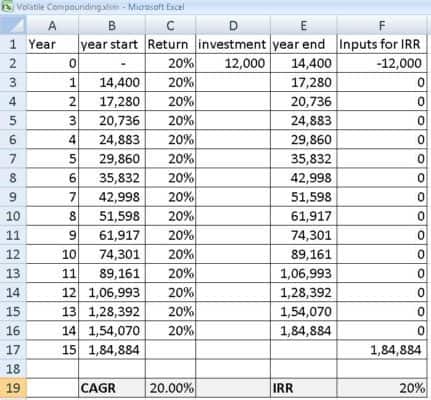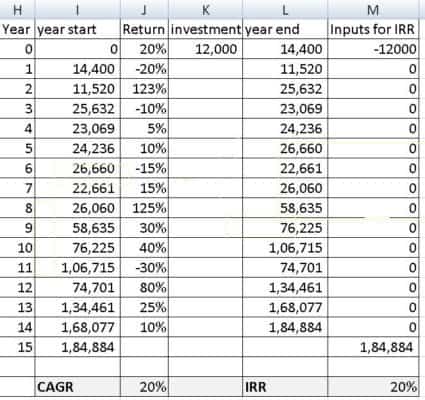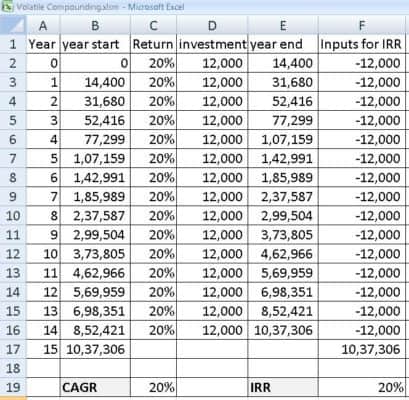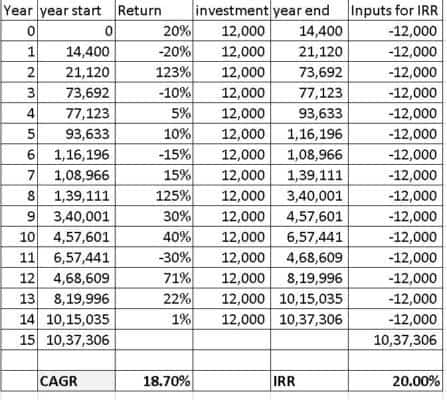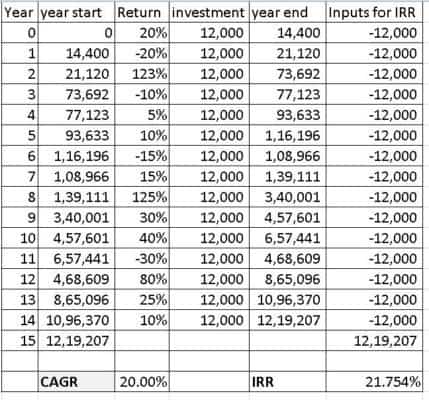Last Updated on July 20, 2016 at 10:20 am
Many of us have trouble understanding how the growth of volatile instruments like equity, bonds gold or even real estate can be quantified. We come across many terms like CAGR, IRR and XIRR in this context.
In this post, the similarity and differences between the CAGR (compounded annualised growth rate) and the IRR (internal rate of return) are examined with the help of an illustration.
First, it is important to understand why compound interest formulae are used for volatile instruments where there is no actual compounding.
We take a risk by investing in a volatile security. So we must be compensated for it. Ideally more than a fixed income product where there is no risk. This is known as a risk premium.
Join 32,000+ readers and get free money management solutions delivered to your inbox! Subscribe to get posts via email! (Link takes you to our email sign-up form)
🔥Want to create a complete financial plan? Learn goal-based investing? Exclusive access to our DIY tools? Increase your income with your skills? Use this link to enjoy massive discounts on our robo-advisory tool & courses! 🔥
The only way I can calculate risk premium is by using the same compounding formula used for the fixed income product to the volatile security. This allows a comparison of returns from the two instruments.
This is why we talk about CAGR and XIRR for stocks.
Let us consider:
- an imaginary instrument which offers a constant return of 20% and
- a highly volatile instrument
I Lump sum investment
Case 1: Constant returns
First, let us consider a one-time investment of 12,000 and let it grow for 15 years.
In this case, the above sheet is an over-kill as all I need to do to find the maturity amount is to calculate
12000 x (1+20%)^15 = 1,84,884 (rounded off)
The CAGR in this case obviously is 20% as the ‘average’ rate at which the money compounds = 20% as there is no variation in yearly returns.
The average that CAGR refers to, is not the arithmetic average that we usually use but the geometric average.
This is given by,
(1+20%) x (1+20%)x (1+20%) ….. x(1+20%) = (1+CAGR)^15
On the left, (1+20%) is multiplied 15 times as that is the investment duration.
So,
1+ CAGR =[ (1+20%) x (1+20%)x (1+20%)x(1+20%) x (1+20%)x (1+20%)x(1+20%) x (1+20%)x (1+20%)x (1+20%) x (1+20%)x (1+20%)(1+20%) x (1+20%)x (1+20%)]
From which the CAGR can be calculated. Of course, when all the annual returns are the same the above expression is trivial to solve:
I expanded it explicitly for us to recognize that when the annual returns fluctuate, we need to plug in each year’s return in the above expression.
Notice the last column in the above table. Those are the inputs for IRR calculation in Excel. Investments are entered as a negative number (-12,000 in this case) and the final maturity value is positive. It is important to enter a zero in the intervening period.
To calculate IRR, all we need to do is to type
=IRR(F2:F17)
in any cell we want. The answer is 20%.
Notice that
CAGR = IRR (lump sum investment and constant returns)
Case 2: Fluctuating returns
Next we will consider a one-time investment in an instrument with highly volatile returns for 15 years.
Notice that the returns fluctuate wildly. However, the maturity value is identical to the above case in which annual returns were fixed at 20%.
This fascinating occurrence is an illustration of volatile growth.
If we set out to calculate the CAGR, we have
1+ CAGR =[ (1+20%) x (1-20%)x (1+123%)x(1-10%) x (1+5%)x (1+10%)x(1-15%) x (1+15%)x (1+125%)x (1+30%) x (1+40%)x (1-30%)(1+80%) x (1+25%)x (1+10%)] (returns are rounded off)
Which gives CAGR =20%
Since the input entries in the IRR column are the same as above, so is the answer, 20%.
So we conclude,
CAGR = IRR (lump sum investment and variable returns)
II Periodic investments
Now we move on to when periodic investments are made.
Case 1: Constant returns
We will assume that each year Rs. 12,000 is invested. Typically the same math used if Rs. 1000 is invested per month.
An example of this type of investment is the recurring deposit.
Again, the annual return is a constant 20%.
In this case, the formula to calculate the maturity value is a bit involved
12000 x (1+20%) x[(1+20%)^15-1]/20% = 10,37,306 (rounded off)
Notice the entries in the IRR entry column.
CAGR = IRR (periodic investment and constant returns)
Case 2: Fluctuating returns
Now for periodic investments in a volatile instrument. This corresponds to SIPs in equity and debt mutual funds or gold ETFs.
Notice that the maturity amount is the same as when returns were constant. However, the IRR is 20% but the CAGR is lower.
If we adjust the returns so that the CAGR is 20%, we get
Notice now that the corpus is much higher (by about 18%) and so is the IRR.
The point is, the notion of a CAGR cannot be used when returns fluctuate and when periodic investments are made.
What is important is to recognise that IRR represents the annualized compounded growth rate (CAGR) if
- a lump sum investment is made in an instrument with constant returns (fixed deposit, bonds)
- a lump sum investment is made in an instrument with variable returns (stocks, mutual funds)
- periodic investments are made in an instrument with constant returns (recurring deposit)
IRR does not represent the CAGR if
- periodic investments are made in an instrument with variable returns (mutual fund SIPs)
In such a case, IRR is a measure of growth but it cannot be equated to CAGR! (many, including me, make this mistake).
IRR cannot be used when investments are not periodic. A monthly SIP is not exactly periodic. For obvious reasons, they are not exactly spaced 30 days apart. So one will have to take into account the date of investments and receipts along with the amounts involved. This is done using the Excel function, XIRR.
It is important to recognise that both IRR and XIRR are approximation techniques and can be troublesome to use when someone loses a lot of money! See an example here
See here to understand how XIRR for a mutual fund SIP is calculated.
Many goal planners (including mine) while calculating corpuses use CAGR and not IRR. As shown above this is incorrect and will end up overestimating the required corpus and hence the monthly investment.
I will redo the goal planners to compute the corpus via IRR. Hopefully this will reduce the stress associated with using a retirement calculator 🙂
Here is the Excel used to generate above scenarios: Compounding with volatile returns

Use our Robo-advisory Tool to create a complete financial plan! ⇐More than 3,000 investors and advisors use this! Use the discount code: robo25 for a 20% discount. Plan your retirement (early, normal, before, and after), as well as non-recurring financial goals (such as child education) and recurring financial goals (like holidays and appliance purchases). The tool would help anyone aged 18 to 80 plan for their retirement, as well as six other non-recurring financial goals and four recurring financial goals, with a detailed cash flow summary.
🔥You can also avail massive discounts on our courses and the freefincal investor circle! 🔥& join our community of 8000+ users!
Track your mutual funds and stock investments with this Google Sheet!
We also publish monthly equity mutual funds, debt and hybrid mutual funds, index funds, and ETF screeners, as well as momentum and low-volatility stock screeners.
You can follow our articles on Google News

We have over 1,000 videos on YouTube!

Join our WhatsApp Channel



- Do you have a comment about the above article? Reach out to us on Twitter: @freefincal or @pattufreefincal
- Have a question? Subscribe to our newsletter using the form below.
- Hit 'reply' to any email from us! We do not offer personalised investment advice. We can write a detailed article without mentioning your name if you have a generic question.
Join 32,000+ readers and get free money management solutions delivered to your inbox! Subscribe to get posts via email! (Link takes you to our email sign-up form)
About The Author
 Dr M. Pattabiraman (PhD) is the founder, managing editor and primary author of freefincal. He is an associate professor at the Indian Institute of Technology, Madras. He has over 13 years of experience publishing news analysis, research and financial product development. Connect with him via Twitter(X), LinkedIn, or YouTube. Pattabiraman has co-authored three print books: (1) You can be rich too with goal-based investing (CNBC TV18) for DIY investors. (2) Gamechanger for young earners. (3) Chinchu Gets a Superpower! for kids. He has also written seven other free e-books on various money management topics. He is a patron and co-founder of “Fee-only India,” an organisation promoting unbiased, commission-free, AUM-independent investment advice.
Dr M. Pattabiraman (PhD) is the founder, managing editor and primary author of freefincal. He is an associate professor at the Indian Institute of Technology, Madras. He has over 13 years of experience publishing news analysis, research and financial product development. Connect with him via Twitter(X), LinkedIn, or YouTube. Pattabiraman has co-authored three print books: (1) You can be rich too with goal-based investing (CNBC TV18) for DIY investors. (2) Gamechanger for young earners. (3) Chinchu Gets a Superpower! for kids. He has also written seven other free e-books on various money management topics. He is a patron and co-founder of “Fee-only India,” an organisation promoting unbiased, commission-free, AUM-independent investment advice.Our flagship course! Learn to manage your portfolio like a pro to achieve your goals regardless of market conditions! ⇐ More than 3,500 investors and advisors are part of our exclusive community! Get clarity on how to plan for your goals and achieve the necessary corpus no matter the market condition!! Watch the first lecture for free! One-time payment! No recurring fees! Life-long access to videos! Reduce fear, uncertainty and doubt while investing! Learn how to plan for your goals before and after retirement with confidence.
Increase your income by getting people to pay for your skills! ⇐ More than 800 salaried employees, entrepreneurs and financial advisors are part of our exclusive community! Learn how to get people to pay for your skills! Whether you are a professional or small business owner seeking more clients through online visibility, or a salaried individual looking for a side income or passive income, we will show you how to achieve this by showcasing your skills and building a community that trusts and pays you. (watch 1st lecture for free). One-time payment! No recurring fees! Life-long access to videos!
Our book for kids: “Chinchu Gets a Superpower!” is now available!


Must-read book even for adults! This is something that every parent should teach their kids right from their young age. The importance of money management and decision making based on their wants and needs. Very nicely written in simple terms. - Arun.Buy the book: Chinchu gets a superpower for your child!
How to profit from content writing: Our new ebook is for those interested in getting a side income via content writing. It is available at a 50% discount for Rs. 500 only!
Do you want to check if the market is overvalued or undervalued? Use our market valuation tool (it will work with any index!), or get the Tactical Buy/Sell timing tool!
We publish monthly mutual fund screeners and momentum, low-volatility stock screeners.
About freefincal & its content policy. Freefincal is a News Media organisation dedicated to providing original analysis, reports, reviews and insights on mutual funds, stocks, investing, retirement and personal finance developments. We do so without conflict of interest and bias. Follow us on Google News. Freefincal serves more than three million readers a year (5 million page views) with articles based only on factual information and detailed analysis by its authors. All statements made will be verified with credible and knowledgeable sources before publication. Freefincal does not publish paid articles, promotions, PR, satire or opinions without data. All opinions will be inferences backed by verifiable, reproducible evidence/data. Contact Information: To get in touch, please use our contact form. (Sponsored posts or paid collaborations will not be entertained.)
Connect with us on social media
- Twitter @freefincal
- Subscribe to our YouTube Videos
- Posts feed via Feedburner.
Our publications
You Can Be Rich Too with Goal-Based Investing
 Published by CNBC TV18, this book is designed to help you ask the right questions and find the correct answers. Additionally, it comes with nine online calculators, allowing you to create custom solutions tailored to your lifestyle. Get it now.
Published by CNBC TV18, this book is designed to help you ask the right questions and find the correct answers. Additionally, it comes with nine online calculators, allowing you to create custom solutions tailored to your lifestyle. Get it now.Gamechanger: Forget Startups, Join Corporate & Still Live the Rich Life You Want
 This book is designed for young earners to get their basics right from the start! It will also help you travel to exotic places at a low cost! Get it or gift it to a young earner.
This book is designed for young earners to get their basics right from the start! It will also help you travel to exotic places at a low cost! Get it or gift it to a young earner.Your Ultimate Guide to Travel
 This is an in-depth exploration of vacation planning, including finding affordable flights, budget accommodations, and practical travel tips. It also examines the benefits of travelling slowly, both financially and psychologically, with links to relevant web pages and guidance at every step. Get the PDF for Rs 300 (instant download)
This is an in-depth exploration of vacation planning, including finding affordable flights, budget accommodations, and practical travel tips. It also examines the benefits of travelling slowly, both financially and psychologically, with links to relevant web pages and guidance at every step. Get the PDF for Rs 300 (instant download)